
Number 6, March
2010

What's Here for You:
Vibration Isolation News is designed to keep our customers and friends up to date on the latest products and applications designed to facilitate better measurements and improved nanomanufacturing. We are an OEM supplier to leading manufacturers of scanning probe microscopes, micro-hardness testers and other sensitive instruments, and we have users at more than 200 leading universities and private and government laboratories in 35 countries.

INDEX
1. An Application
Comparison: Air Tables versus Negative Stiffness Technology
2. Featured
Product: BM-10 Low Profile Isolator Used Where Vertical
Space Matters
3. Featured
Application: Motion in Review-Negative-Stiffness Vibration
Isolation at Yale University
4. Upcoming
Nanotechnology Meetings and Webinars
5. Our latest Ad
6. Your comments and suggestions

An Application
Comparison: Air Tables versus Negative Stiffness Technology
Negative-stiffness
vibration isolators provide a significant improvement over
air tables in vibration-sensitive environments
Excerpted
from MR0 Today - June/July 2008
Although
air tables have been around for the better part of a half-century,
their usefulness as an efficient method for vibration isolation
is now being seriously challenged by the more compact and
effective Negative-Stiffness vibration isolators
By
Jim McMahon
For almost forty years pneumatic vibration isolators have
been the mainstay for stabilizing industrial and academia's
most critical micro-engineering instrumentation. But, just
as technology has been steadily migrating from micro to
nano, so has the need for more precise vibration isolation
in microelectronics fabrication, industrial laser/optical
systems and biological research. These so called "passive
system" air tables are now being seriously challenged
by the newer Negative-Stiffness vibration isolators. Negative-Stiffness
isolation is rapidly gaining popularity in industrial and
laboratory environments, and to no small degree because
of its ability to effectively isolate vibration in diverse
and challenging environments.
An isolator is used to solve a problem, and how bad the
problem is determines the solution you need. Since the 1960's
air tables have been used for isolation. Basically cans
of air, they are still the most popular isolators used.
But, air tables with resonant frequencies at 2 to 2-1/2
Hz can typically only handle vibrations down to about 8
to 10 Hz, not quite low enough for optimum performance with
modern nano-equipment. Also, greater isolation efficiencies
are needed in the frequency ranges air isolators can handle.
For purposes of clarity in scanning probe microscopes and
interferometers, air tables are an inefficient isolation
solution. The air systems have been adequate up until a
few years ago when better isolation was required.
Because of its very high isolation efficiencies, Negative-Stiffness
vibration isolation systems enable vibration-sensitive instruments
such as scanning probe microscopes, micro-hardness testers,
profilers and scanning electron microscopes to operate in
harsh conditions and severe vibration environments that
would not be practical with top-performance air tables and
other pneumatic isolation systems.
Negative-Stiffness versus Air Isolation
Following are ten key points which demonstrate the benefits
of Negative-Stiffness isolators compared to air isolation
systems:
#1: Low Hertz Perturbations
An air table will amplify vibrations in a typical range
of 2 to 7Hz, this is because of the natural frequencies
where air tables resonate. All isolators will amplify at
their resonant frequency, and then they will start isolating.
So, with an air table, any vibration in that range could
not only fail to be mitigated, it could be amplified. The
low cycle perturbations would just come straight through
to the instrument.
Negative-Stiffness isolators resonate at 0.5Hz. At this
frequency there is almost no energy present. It would be
very unusual to find a significant vibration at 0.5Hz.
#2: Image Clarity
Negative-Stiffness vibration isolation can reduce vibration
noise levels in Atomic Force Microscopes, for example, by
a factor of 2 to 3 when compared with top-performance air
tables. This is particularly significant for noise levels
in the sub-Angstrom range. This results in clearer images
and features not discernable with pneumatic isolation systems.
#3: Severe Vibration Environments
As nano-equipment use becomes more prevalent, lab sites
are being set up in much more severe vibration-prone environments,
such as upper floors of buildings and clean rooms. Such
severe vibration locations are too extreme for pneumatic
isolators to effectively do their job.
But Negative-Stiffness isolators perform well in such environments,
producing much better images and data than can be obtained
with even the best high-performance air tables.
#4: Harsh Environments - Vacuums,
High/Low Temperature Extremes, Radiation
Air tables are not particularly compatible when it comes
to operating in vacuums, extreme high and low temperatures,
and radiation. Yet these harsh operating environments are
often necessary when conducting research and testing, such
as with cryogenic chambers in semiconductor research.
All metal Negative-Stiffness systems can be configured which
are compatible with high vacuums and other adverse environments,
such as extreme high and low temperatures, and radiation.
With vacuums, for example, Negative-Stiffness isolators
can be used right inside the vacuum chambers. This offers
other advantages such as much lower payload weights, more
compact systems, and eliminates problems associated with
vacuum chamber feed-through.
#5: Compressed Air
Air tables require a constant supply of compressed air.
This requires either a dedicated compressed air line to
be plumbed in to your lab, a tank of pressurized gas or
a small compressor.
Even if you are lucky enough to have a dedicated compressed
air line your table's location is still limited by the length
of air line you have. Large tanks of compressed gas have
to be mounted very securely to minimize their danger. Changing
the tanks can be quite difficult and inconvenient as well.
Compressors are sources of both mechanical and acoustic
noise and are very poor choices from a vibration standpoint.
If you can get your nano-environment mechanically isolated
without having to deal with compressed air to run your vibration
isolator, then you will be better off. The nice thing about
Negative-Stiffness isolators is they do not require compressed
air. They operate purely in a mechanical mode. One less
thing you have to worry about when you are setting up your
lab and working in it.
#6: Location Selection for Vibration-Sensitive
Equipment
Let's face it, air tables are big, bulky structures, they
take up a lot of lab space. The high-performance air tables
are even bigger. This can become a limiting factor when
laying out the equipment in your lab.
Negative-Stiffness isolators are available in high-performance
bench top configurations, considerably more compact than
air tables and easy to move around. They are also available
as workstations, tables and floor platforms where these
configurations are required.
#7: Load Adjustment
Low-frequency passive vibration isolators are somewhat sensitive
to small changes in weight loads, as well as to large displacements.
Pneumatic systems utilize leveling valves to mitigate the
problem.
Negative-Stiffness isolators provide a very simple manual
adjustment to accommodate variations in weight loads. For
applications where manual load adjustment is not practical
they provide an auto-adjust system that maintains the isolator
in a precise vertical equilibrium position.
#8: Scanning Probe Microscopes
Scanning Probe Microscopes (SPMs) have vibration isolation
requirements that are unparalleled in the metrology world.
The vertical axis is the most sensitive for most SPMs. They
can also be quite sensitive to vibrations in the horizontal
axes. In order to achieve the lowest possible noise floor,
on the order of an Angstrom, isolation is always used.
Bench top air systems provide limited isolation vertically
and very little isolation horizontally. Negative-Stiffness
isolators provide increased isolation performance for SPMs
over air tables, while offering better ease-of-use and no
facility requirements.
Negative-Stiffness isolators have the flexibility of custom
tailoring resonant frequencies vertically and horizontally.
#9: Laser/Optical Equipment
Laser and optical systems, whether used in an academic lab
or in an industrial environment, are very susceptible to
vibrations from the environment. These instruments almost
always need vibration isolation. Traditionally, large air
tables have been the isolators preferred for optical systems,
but Negative-Stiffness isolators are becoming a popular
choice. Negative-Stiffness isolators provide 10 to100 times
the performance of air tables, depending on the vibration
frequency.
Laser based interferometers are extremely sensitive devices
that are capable of resolving nanometer scale motions and
features. They often have very long mechanical paths which
makes them even more sensitive to vibrations. The sophisticated
modern ellipsometry techniques that allow this high performance
rely on low noise to be able to detect fringe movement.
Properly isolating an interferometer will allow it to provide
the highest possible resolution.
Optical profilers have similar sensitivity to vibrations.
Optical component systems are often quite complex. The long
optical paths can lead to angular magnification of vibrations.
Optical air tables can make the problems worse since they
have a resonant frequency that often matches that of floor
vibrations. Negative-Stiffness 0.5Hz isolators provide isolation
in these environments when air tables simply cannot.
#10: Maintenance and Expense
Because Negative-Stiffness isolators utilize simple elastic
structures and viscoelastic materials that deform, their
isolation performance does not degrade with micromotions
typical of laboratory floors and fabrication rooms, as do
conventional pneumatic isolators.
Cost-wise, Negative-Stiffness isolators are comparably priced
to air isolators or lower priced for many applications.
The Need for a Better Vibration Isolation Solution
The need for vibration isolation will continue to increase
in importance as the precision of research and test applications
embraces smaller and smaller magnitudes of scale.
As industrial researchers and universities continue to broaden
their nano-tech work, necessitating more sensitive equipment
and expanded lab facilities, vibration-handicapped environments
will become more prevalent, and a better vibration isolation
solution will be required than what has been available for
the past almost half-century with air tables. It appears
Negative-Stiffness vibration isolation will fill that void.
The full
article can be found at: https://minusk.com/content/in-the-news/mro_today_june-july_2008.html

Featured Product: BM-10 Low Profile Isolator Used Where Vertical Space Matters
The
BM-10 bench top platform offers 10-100 times better performance
than a full size air table in a package only 4.6 inches
tall and 12 inches wide and deep. It also does this without
any air or electricity!
This vibration isolation platform is extremely easy to
use and offers extreme performance. It offers a 1.5Hz
horizontal natural frequency and our signature 0.5 Hz
vertical natural frequency. There are only two adjustments.
The BM-10 is perfect for new generations of small SPM's
that require the highest performance in a very compact
system.
This is the thinnest, smallest footprint, most portable,
and most user-friendly isolator ever offered that is capable
of delivering this level of performance.
The curve below shows the vertical ½ Hz performance
of the BM-10. It offers 10-100 times better performance
than an air table in a package many times smaller.
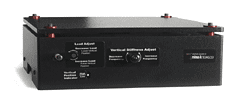
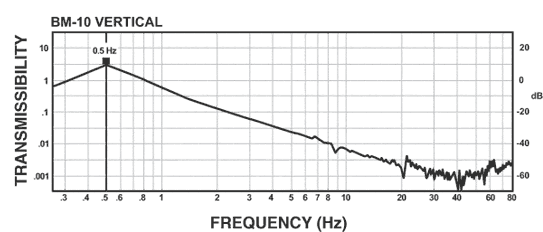
Minus K's BM-10 Bench Top Vibration Isolator
Typical
transmissibility curve with 1/2 Hz natural Frequency
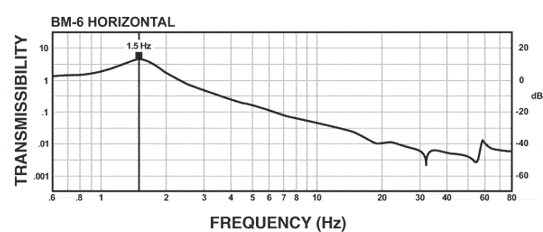
The horizontal isolation performance of the BM-10 is the same as that of the BM-6.
Applications have included the full spectrum from Scanning Probe Microscopes (AFM, STM, NSOM, etc) and Laser/Optical systems through neurosciences, electronics, and even audio reproduction.Because Minus K products can be used under vacuum conditions and require no power for their operation, they have been used in applications ranging from ground tests of spacecraft to sensitive experiments where there can be no stray electromagnetic fields.
https://minusk.com/content/products/standard/bm-10.html

Featured
Application
Negative-Stiffness Vibration Isolation at Yale University
Excerpted from Today's Medical
Developments - March 2009
Motion in Review
By
Dr. David L. Platus, President and Founder, Minus K Technology,
Inc.
LED BY PROFESSOR LAWRENCE E. COHEN PH.D.OF YALE UNIVERSITY'S
DEPARTMENT OF CELLULAR AND MOLECULAR PHYSIOLOGY, the
small lab in room BE58 at the Yale School of Medicine has
been conducting research on neuronal activity in brain cells
to develop methods for imaging brain activity, and then
uses these methods to study the brain. The university has
been developing the method for imaging brain activity for
42 years, but it was not until several years ago that the
lab opted to move to a higher level of vibration isolation
technology to support its microscopy-imaging.
It is not unusual for universities, and industry for that
matter, to have to deal with vibrations that compromise
the imaging quality and data sets that they acquire through
microscopy. Although it is certainly the desire of every
lab to rid the unwanted vibration, conventional systems
such as air tables, have not been successful in providing
an adequate level of vibration isolation for ultra-sensitive
equipment measuring at the Angstrom and micron levels.
Such was the case with Cohen's lab at Yale, where air tables
had been the mainstay for the lab's vibration isolation
for many, many years. But now, for adequate isolation to
conduct its neuronal research at the micron level, the air
tables were not able to provide the vibration isolation
needed for the lab's research.
"Monitoring many neurons or regions simultaneously
can improve our understanding about how nervous systems
are organized," Cohen continues. "For example,
the cells in your spinal cord have to get information from
your toe, and also send information to your toe. That signal
is a propagated electrical wave of membrane potential, and
dyeing that membrane can provide an optical signal that
is used to measure that propagated wave."
The lab uses a high-speed camera to view these changes.
It has a speed of 2,000 frames-per-second with very high
quantum efficiency, which is the quantity of photons that
get converted into electrons. The camera has a quantum efficiency
of about 0.9, which converts almost all the photons into
electrons.
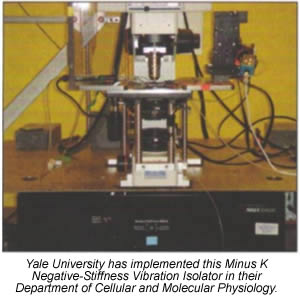 In
the lab's optical monitoring of brain activity,
each pixel in the recording receives light from
a small portion of neurons which have been stained
by microinjection of the dye into the brain. After
waiting for the dye to spread into the processes,
the dye can be used to monitor changes in membrane
potential in dendrites and axons.
In
the lab's optical monitoring of brain activity,
each pixel in the recording receives light from
a small portion of neurons which have been stained
by microinjection of the dye into the brain. After
waiting for the dye to spread into the processes,
the dye can be used to monitor changes in membrane
potential in dendrites and axons.
When a low magnification objective is used to form
an image of a vertebrate preparation on the lab's
464 element photodiode array, or 80 x 80 pixel CCD
camera, each pixel receives light from hundreds
or thousands of neurons.
It is also using a variety of microscopes to conduct
this research including a laser scanning 2-photon
microscope and an optical microscope. At this time,
only the optical microscope is set on the Negative-Stiffness
vibration isolation system, built by Minus K Technology.
"Measuring
in the dimension of microns still requires vibration isolation
because it is so small,'' Cohen says. ''Any small movement
in the lab environment makes a big effect. If you are viewing
at 10 , and it vibrates by 10 , then you are in big trouble.
"We were using air tables before, but the Negative-Stiffness
isolator is much better," Cohen continues. "It
reduces the vibration by a larger faction because it reduces
the vibration in the X/Y plane just as well as in the Z
plane, where the air table does not do well at all on the
X/Y plane.
Putting up with lab vibration noise problems for any amount
of time, let alone for a period of years, can only be costly
in terms of lost production, and will certainly inhibit
the progress of the research.
The
full article can be found at:
https://minusk.com/content/in-the-news/today's_medical_developments_march_2009.html

Upcoming Meetings and Webinars:
| Meeting: | Sponsor: | Dates: | Location: |
| Bozen Symposium on "Functional Nanoscience" | Beilstein Institute | May.
17, 2010 - May. 21, 2010 |
Bolzano, Italy |
| Short
Abstract: The
Beilstein Bozen symposia address contemporary issues in the
chemical and related sciences by employing an interdisciplinary
approach. Topics: Self-organization/Molecular self-assembly, Molecular motors and transport, Self-replicating biomimetic systems, Molecular magnets, Quantum effects, Imaging, Manipulation of molecules at the atomic scale/Single molecule reactions http://www.ausnano.net/iconn2010/ |
|||
| Nanotech China | Cosponsors Include: Agilent, Veeco, JEOL | May.
27, 2010 - May. 29, 2010 |
Shanghai, China |
| NSTI Nanotech 2010 | Nano
Science and Technology Institute Visit the Minus K Booth #636 at this exhibit |
Jun.
22, 2010 - Jun. 23, 2010 |
Anaheim, CA |
Short
Abstract: Nanotech
2010 rings together over 5,000 technology and business leaders
and experts from academia, government, startups and Fortune
1,000 companies. |
|||
| SPIE Optics & Photonics | Visit Minus K Booth #523 at this exhibit | Aug.
3, 2010 - Aug. 5, 2010 |
San Diego, CA |
| http://spie.org/optics-photonics.xml | |||

Comments/Suggestions: Applications in New Fields or Features of Interest to You in Our Next Newsletter:
This ad will be featured in Photonics Online and The Acoustical
Society of America (JASA)
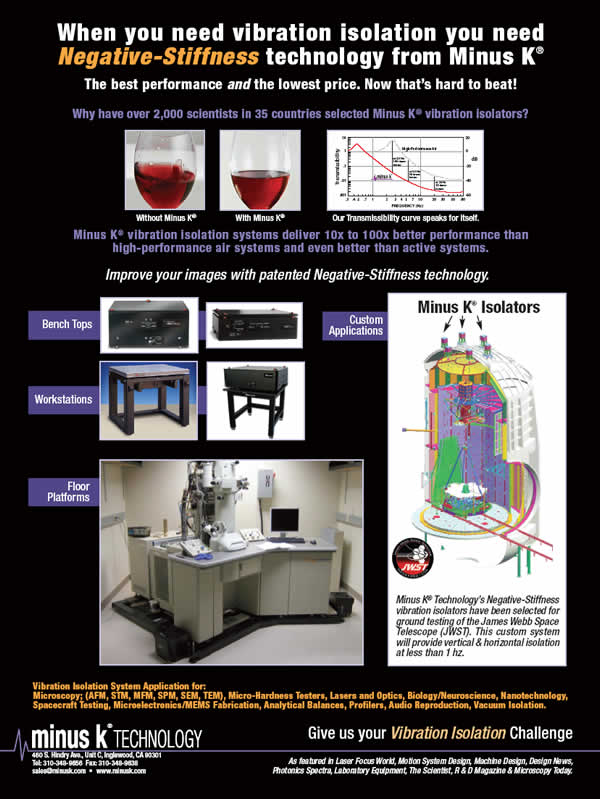

If you want
to share your application with our readers, please send us a description
so that we can publish it in an upcoming newsletter. If you have
comments or suggestions we would be very interested to read them.
Please send any materials to: david.resnik@minusk.com

Tel: 310-348-9656 Fax: 310-348-9638
Contact Us www.MinusK.com
© Minus K Technology Inc., Vibration Isolation Systems. All rights reserved.